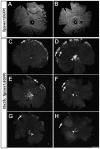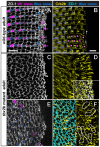Patterning the cone mosaic array in zebrafish retina requires specification of ultraviolet-sensitive cones
- PMID: 24465536
- PMCID: PMC3897441
- DOI: 10.1371/journal.pone.0085325
Patterning the cone mosaic array in zebrafish retina requires specification of ultraviolet-sensitive cones
Abstract
Cone photoreceptors in teleost fish are organized in precise, crystalline arrays in the epithelial plane of the retina. In zebrafish, four distinct morphological/spectral cone types occupy specific, invariant positions within a regular lattice. The cone lattice is aligned orthogonal and parallel to circumference of the retinal hemisphere: it emerges as cones generated in a germinal zone at the retinal periphery are incorporated as single-cell columns into the cone lattice. Genetic disruption of the transcription factor Tbx2b eliminates most of the cone subtype maximally sensitive to ultraviolet (UV) wavelengths and also perturbs the long-range organization of the cone lattice. In the tbx2b mutant, the other three cone types (red, green, and blue cones) are specified in the correct proportion, differentiate normally, and acquire normal, planar polarized adhesive interactions mediated by Crumbs 2a and Crumbs 2b. Quantitative image analysis of cell adjacency revealed that the cones in the tbx2b mutant primarily have two nearest neighbors and align in single-cell-wide column fragments that are separated by rod photoreceptors. Some UV cones differentiate at the dorsal retinal margin in the tbx2b mutant, although they are severely dysmorphic and are eventually eliminated. Incorporating loss of UV cones during formation of cone columns at the margin into our previously published mathematical model of zebrafish cone mosaic formation (which uses bidirectional interactions between planar cell polarity proteins and anisotropic mechanical stresses in the plane of the retinal epithelium to generate regular columns of cones parallel to the margin) reproduces many features of the pattern disruptions seen in the tbx2b mutant.
Conflict of interest statement
Figures











Similar articles
-
gdf6a is required for cone photoreceptor subtype differentiation and for the actions of tbx2b in determining rod versus cone photoreceptor fate.PLoS One. 2014 Mar 28;9(3):e92991. doi: 10.1371/journal.pone.0092991. eCollection 2014. PLoS One. 2014. PMID: 24681822 Free PMC article.
-
Tbx2b is required for ultraviolet photoreceptor cell specification during zebrafish retinal development.Proc Natl Acad Sci U S A. 2009 Feb 10;106(6):2023-8. doi: 10.1073/pnas.0809439106. Epub 2009 Jan 28. Proc Natl Acad Sci U S A. 2009. PMID: 19179291 Free PMC article.
-
Photoreceptor Progenitors Depend Upon Coordination of gdf6a, thrβ, and tbx2b to Generate Precise Populations of Cone Photoreceptor Subtypes.Invest Ophthalmol Vis Sci. 2018 Dec 3;59(15):6089-6101. doi: 10.1167/iovs.18-24461. Invest Ophthalmol Vis Sci. 2018. PMID: 30592497
-
A moving wave patterns the cone photoreceptor mosaic array in the zebrafish retina.Int J Dev Biol. 2004;48(8-9):935-45. doi: 10.1387/ijdb.041873pr. Int J Dev Biol. 2004. PMID: 15558484 Review.
-
Tuning outer segment Ca2+ homeostasis to phototransduction in rods and cones.Adv Exp Med Biol. 2002;514:179-203. doi: 10.1007/978-1-4615-0121-3_11. Adv Exp Med Biol. 2002. PMID: 12596922 Review.
Cited by
-
Characterization of optic nerve regeneration using transgenic zebrafish.Front Cell Neurosci. 2015 Apr 9;9:118. doi: 10.3389/fncel.2015.00118. eCollection 2015. Front Cell Neurosci. 2015. PMID: 25914619 Free PMC article.
-
A dual role of the extracellular domain of Drosophila Crumbs for morphogenesis of the embryonic neuroectoderm.Biol Open. 2018 Jan 26;7(1):bio031435. doi: 10.1242/bio.031435. Biol Open. 2018. PMID: 29374056 Free PMC article.
-
Novel Animal Model of Crumbs-Dependent Progressive Retinal Degeneration That Targets Specific Cone Subtypes.Invest Ophthalmol Vis Sci. 2018 Jan 1;59(1):505-518. doi: 10.1167/iovs.17-22572. Invest Ophthalmol Vis Sci. 2018. PMID: 29368007 Free PMC article.
-
Imaging the adult zebrafish cone mosaic using optical coherence tomography.Vis Neurosci. 2016 Jan;33:E011. doi: 10.1017/S0952523816000092. Vis Neurosci. 2016. PMID: 28177275 Free PMC article.
-
Rods Contribute to Visual Behavior in Larval Zebrafish.Invest Ophthalmol Vis Sci. 2020 Oct 1;61(12):11. doi: 10.1167/iovs.61.12.11. Invest Ophthalmol Vis Sci. 2020. PMID: 33049059 Free PMC article.
References
-
- Dowling JE (1987) The Retina: An Approachable Part of the Brain. Cambridge, Mass.: Belknap Press of Harvard University Press. 282 pp.
-
- Williams DS, Arikawa K, Paallysaho T (1990) Cytoskeletal components of the adherens junctions between the photoreceptors and the supportive Müller cells. J Comp Neurol 295: 155–164. - PubMed
-
- Gosens I, den Hollander AI, Cremers FP, Roepman R (2008) Composition and function of the Crumbs protein complex in the mammalian retina. Exp Eye Res 86: 713–726. - PubMed
-
- Lyall AH (1957) Cone arrangements in teleost retinae. Quart J Microsc Sci 98: 189–201.
-
- Engström K (1963) Cone types and cone arrangements in teleost retinae. Acta Zool 44: 179–243.
Publication types
MeSH terms
Substances
Grants and funding
LinkOut - more resources
Full Text Sources
Other Literature Sources
Molecular Biology Databases
Research Materials

